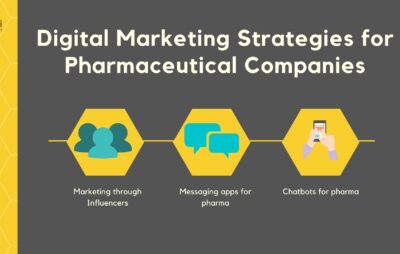In recent years, digital marketing has become an increasingly important tool for pharmaceutical companies to reach their target audiences and build brand awareness. However, the industry’s unique challenges mean that digital marketing strategies need to be carefully tailored to meet pharmaceutical companies’ specific needs.
One of the biggest challenges facing pharmaceutical companies is the need to comply with strict regulations around advertising and marketing. This means that digital marketing strategies need to be carefully designed to ensure that they are compliant with all relevant regulations. At the same time, pharmaceutical companies need to build trust with their audiences by providing reliable, accurate information about their products and services.

Despite these challenges, digital marketing can be an incredibly effective tool for pharmaceutical companies. By leveraging the power of digital channels such as social media, email marketing, and search engine optimization, pharmaceutical companies can reach a wider audience than ever. Additionally, digital marketing strategies can be highly targeted, allowing companies to reach specific audiences with tailored messaging and content.
1. Understanding the Pharmaceutical Market
As a pharmaceutical company, it is crucial to understand the market before developing a digital marketing strategy. This section will cover two key areas to help you understand the pharmaceutical market: market analysis and target audience identification.
Market Analysis

Before launching a digital marketing campaign, it is essential to conduct a market analysis. This analysis should include evaluating current market trends, including competition, regulatory constraints, and scientific complexities. You should also analyze the demand for your products, the market size, and potential growth opportunities.
One way to conduct market analysis is to use SWOT analysis. This analysis helps you identify the strengths, weaknesses, opportunities, and threats in the market. By identifying these factors, you can develop a marketing strategy that leverages your strengths, addresses your weaknesses, takes advantage of opportunities, and mitigates threats.
Target Audience Identification

Identifying your target audience is critical to developing a successful digital marketing strategy. Your target audience may include healthcare professionals, patients, caregivers, or a combination of these groups. You should identify the specific needs, wants, and pain points of your target audience to develop messaging that resonates with them.
To identify your target audience, you can use market research, including surveys, focus groups, and data analysis. You can also use social media listening tools to monitor online conversations and identify trends and insights.
Once you have identified your target audience, you can develop a buyer persona. A buyer persona is a fictional representation of your ideal customer. It includes demographic information, such as age, gender, and location, as well as psychographic information, such as values, beliefs, and behaviors. By developing a buyer persona, you can tailor your marketing messages to your target audience and increase the effectiveness of your digital marketing campaigns.
Understanding the pharmaceutical market is crucial to developing a successful digital marketing strategy. Before launching a digital marketing campaign, focus on conducting a market analysis and identifying your target audience. Then you can leverage the insights you get tocan develop a marketing strategy that resonates with your target audience and drives conversions.
2. Developing a Digital Marketing Plan

To create an effective digital marketing plan for your pharmaceutical company, you need to identify clear strategic goals and allocate your budget accordingly. This will help you to maximize your return on investment (ROI) and achieve your desired outcomes.
Strategic Goals Setting
The first step in developing a digital marketing plan is to set strategic goals. These goals should be specific, measurable, achievable, relevant, and time-bound (SMART). Examples of strategic goals for pharmaceutical companies may include:

- Increasing brand awareness among healthcare professionals and patients
- Generating leads and sales for specific products or services
- Improving patient engagement and adherence to treatment plans
- Enhancing customer satisfaction and loyalty
- Establishing thought leadership in a specific therapeutic area
- Building a strong online reputation and social media presence
Once you have identified your strategic goals, you can develop a digital marketing strategy that is tailored to your specific needs and objectives.
Budget Allocation

The next step in developing a digital marketing plan is to allocate your budget. You should consider the following factors when determining your budget:
- The size and scope of your digital marketing campaign
- The level of competition in your industry and target market
- The cost of different digital marketing channels and tactics
- The expected ROI of your digital marketing campaign
You may want to allocate your budget across multiple digital marketing channels and tactics, such as:
- Search engine optimization (SEO) and search engine marketing (SEM)
- Social media marketing (SMM) and influencer marketing
- Email marketing and marketing automation
- Content marketing and thought leadership
- Mobile marketing and app development
- Analytics and data management
By allocating your budget effectively, you can ensure that you invest in the digital marketing channels and tactics that will deliver the best results for your pharmaceutical company.
3. Digital Marketing Strategies for Pharmaceutical companies
Content Marketing and SEO
When it comes to digital marketing strategies for pharmaceutical companies, content marketing and search engine optimization (SEO) are two essential components that work hand in hand to improve visibility, credibility, and engagement.

Educational Content Creation
Creating educational content is a powerful way to build trust and establish authority in the pharmaceutical industry. By providing valuable information that addresses the needs and concerns of your target audience, you can position your brand as a reliable source of knowledge and expertise. Examples of educational content that pharmaceutical companies can create include:
- Disease information and management tips
- Treatment options and side effects
- Clinical trial results and updates
- Lifestyle and wellness advice
- Infographics, videos, and other visual content
To create effective educational content, it’s important to understand your target audience’s interests, preferences, and pain points. Conducting market research, analyzing search trends, and monitoring social media conversations can help you identify the topics and formats that resonate with your audience.
Search Engine Optimization

Search engine optimization (SEO) is the process of optimizing your website and content to rank higher in search engine results pages (SERPs) for relevant keywords and phrases. By improving your visibility on search engines like Google, you can attract more organic traffic, generate more leads, and increase your brand awareness.
To optimize your website and content for SEO, you need to focus on several factors, including:
- Keyword research and optimization
- On-page optimization (title tags, meta descriptions, header tags, etc.)
- Content quality and relevance
- User experience (site speed, mobile-friendliness, etc.)
- Link building and backlinking
Combining these tactics can improve your website’s ranking on search engines and attract more qualified traffic. However, it’s important to note that SEO is a long-term strategy that requires continuous optimization and monitoring to achieve sustainable results.
4. Social Media and Influencer Partnerships
Social media and influencer partnerships are essential components of any effective digital marketing strategy for pharmaceutical companies. Social media platforms provide a unique opportunity for pharmaceutical companies to connect with their audience, build brand awareness, and promote their products and services. Influencer marketing, on the other hand, allows companies to leverage the reach and influence of trusted individuals to promote their products and services.
Platform Selection
When it comes to social media platforms, you should consider the demographics of your target audience and choose the platforms that are most popular among them. For example, if the target audience is primarily older adults, Facebook may be the best platform. Instagram or TikTok may be more effective if the target audience is younger.
It’s important to note that different platforms have different strengths and weaknesses. For example, Instagram is great for visual content, while Twitter is better for short, snappy updates. Pharmaceutical companies should choose the platforms that best align with their marketing goals and the type of content they want to create.
Influencer Marketing
Influencer marketing can be a powerful tool for pharmaceutical companies, but it’s important to choose the right influencers to partner with. Companies should look for influencers who have a large and engaged following, as well as a strong reputation for honesty and authenticity.
When collaborating with influencers, it’s important to be transparent about the nature of the partnership and to ensure that all content complies with regulatory guidelines. Pharmaceutical companies should also work closely with influencers to develop content that aligns with their marketing goals and resonates with their target audience.
Overall, social media and influencer partnerships can be highly effective digital marketing strategies for pharmaceutical companies. By choosing the right platforms and influencers, companies can build brand awareness, connect with their audience, and drive sales and revenue.
5. Regulatory Compliance and Ethical Considerations
When it comes to digital marketing strategies for pharmaceutical companies, regulatory compliance and ethical considerations are of the utmost importance. The pharmaceutical industry is highly regulated, and strict guidelines must be followed to ensure that marketing efforts are moral and legal.
One of the most important regulatory bodies in the pharmaceutical industry is the FDA. The FDA regulates the marketing and promotion of prescription drugs, and pharmaceutical companies must comply with the FDA’s guidelines when developing marketing strategies. This includes ensuring that all marketing materials are truthful, accurate, and not misleading.
In addition to FDA regulations, pharmaceutical companies must also comply with guidelines set forth by other regulatory bodies, such as the Federal Trade Commission (FTC) and the Office of Inspector General (OIG). The FTC regulates advertising practices and prohibits false or misleading claims, while the OIG focuses on preventing fraud and abuse in the healthcare industry.
To ensure regulatory compliance and ethical marketing practices, pharmaceutical companies should consider implementing the following strategies:

- Conduct regular training sessions for marketing teams to ensure that they are up-to-date on regulatory guidelines and ethical considerations.
- Develop a comprehensive review process for all marketing materials to ensure that they are accurate and comply with regulatory guidelines.
- Use clear and concise language in all marketing materials to avoid any confusion or misunderstanding.
- Avoid making exaggerated or false claims about pharmaceutical products and their benefits.
- Be transparent about any potential risks or side effects associated with pharmaceutical products.
- Avoid marketing directly to consumers for prescription drugs, as this is not allowed in many countries.
By following these digital marketing strategies, pharmaceutical companies can ensure that their digital marketing efforts are both ethical and compliant with regulatory guidelines.
In conclusion, we’ve seen how incorporating digital marketing strategies can greatly impact pharmaceutical companies, not just in their sales and marketing sector but also in getting people to know about their work.
If you liked this article, you might also like: Navigating 6 Regulatory Challenges in Healthcare Marketing.






